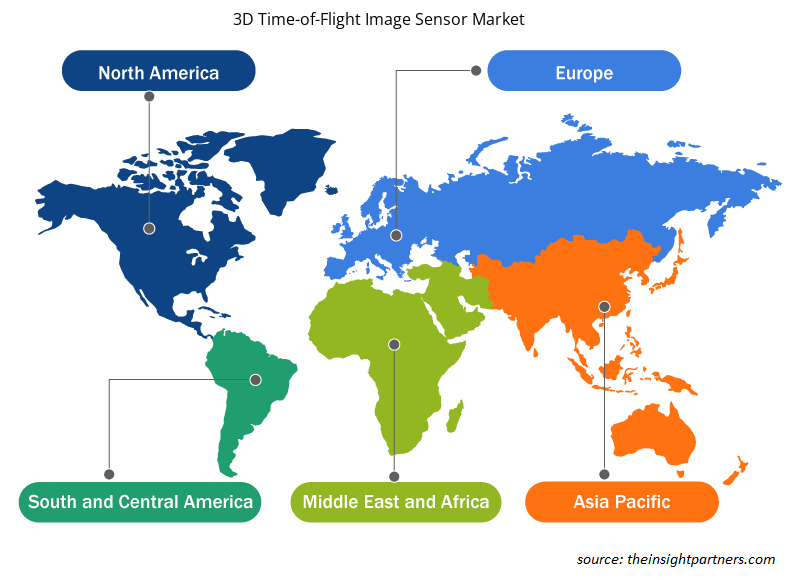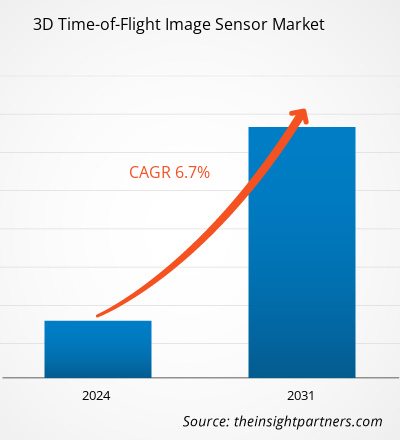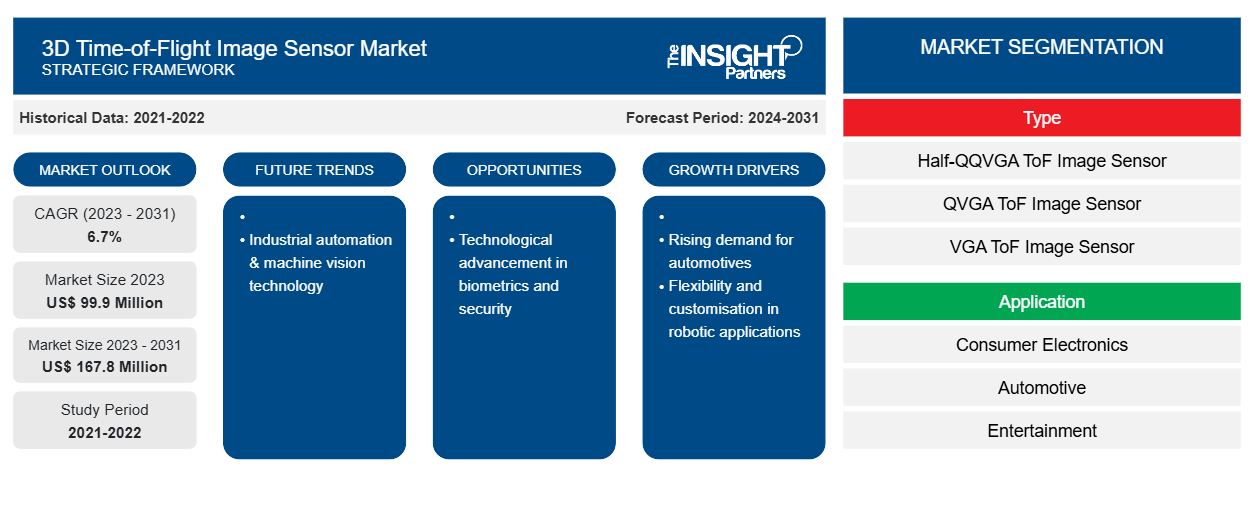Der Markt für 3D-Time-of-Flight-Bildsensoren soll von 99,9 Millionen US-Dollar im Jahr 2023 auf 167,8 Millionen US-Dollar im Jahr 2031 anwachsen. Der Markt soll zwischen 2023 und 2031 eine durchschnittliche jährliche Wachstumsrate (CAGR) von 6,70 % verzeichnen. Die wachsende Nachfrage nach Unterhaltungselektronik sowie Flexibilität und Anpassung bei Roboteranwendungen dürften weiterhin die wichtigsten globalen Trends auf dem Markt für 3D-Time-of-Flight-Bildsensoren bleiben.
Globale Marktanalyse für 3D-Time-of-Flight-Bildsensoren
TOF-Systeme für die Innenraumerfassung bieten im Allgemeinen eine Distanzgenauigkeit von 1 % (entspricht 1 cm) innerhalb eines Meterbereichs bei Verwendung eines einzelnen VCSEL. Die Verwendung von Time-of-Flight-Sensoren (TOF) in Roboteranwendungen bietet zahlreiche Vorteile. Diese Sensoren liefern im Allgemeinen genauere Tiefenmessungen als 2D-Kamera-Videostreams, die durch Bildanalyse verarbeitet werden. Darüber hinaus sind TOF-Kameras für ihr Fehlen beweglicher Komponenten, ihren kompakten Formfaktor und ihre kostengünstige Produktion bekannt. Sie sind besonders wertvoll für Echtzeitanwendungen und liefern außergewöhnlich präzise Tiefendaten bei Geschwindigkeiten von bis zu 60 Bildern pro Sekunde.
Globaler Marktüberblick über 3D-Time-of-Flight-Bildsensoren
Die 3D-Time-of-Flight-Bildsensortechnologie (TOF) ist ein revolutionärer Fortschritt in der Bildverarbeitungsbranche. Durch die Verwendung eines kostengünstigen CMOS-Pixelarrays zusammen mit einer aktiv modulierten Lichtquelle ermöglicht diese Technologie 3D-Bildgebung. Sie funktioniert, indem sie die Zeit misst, die Lichtimpulse benötigen, um eine Distanz durch ein Medium zurückzulegen. Diese bahnbrechende Innovation ermöglicht die Echtzeiterfassung einer echten 3D-Tiefenkarte der physischen Welt. Sie wandelt die Szene, die Umgebung und alle Objekte im aufgenommenen Bild effektiv in den digitalen Raum um. Die integrierten Algorithmen des Sensors werden dann verwendet, um die relative Entfernung zwischen jedem Objekt und der Lichtquelle sowie die Abmessungen der Objekte zu messen.
Passen Sie diesen Bericht Ihren Anforderungen an
Sie erhalten kostenlose Anpassungen an jedem Bericht, einschließlich Teilen dieses Berichts oder einer Analyse auf Länderebene, eines Excel-Datenpakets sowie tolle Angebote und Rabatte für Start-ups und Universitäten.
-
Holen Sie sich die wichtigsten Markttrends aus diesem Bericht.Dieses KOSTENLOSE Beispiel umfasst eine Datenanalyse von Markttrends bis hin zu Schätzungen und Prognosen.
Treiber und Chancen auf dem globalen Markt für 3D-Time-of-Flight-Bildsensoren
Die zunehmende Konvergenz von Unterhaltungselektronik in der Automobilindustrie und die wachsenden Anforderungen autonomer Fahrzeuge
Der Automobilsektor hat erhebliche Veränderungen erfahren, um das Fahrerlebnis zu verbessern. Die heutigen Fahrzeuge werden intelligenter, können sich selbst diagnostizieren und kommunizieren besser mit anderen Fahrzeugen auf der Straße. Trends wie Advanced Driver Assistant Systems (ADAS), Infotainmentsysteme und Fahrzeugtelematik haben in der Automobilindustrie an Bedeutung gewonnen. Diese Fortschritte sind größtenteils auf die Raffinesse und den technologischen Fortschritt in der Halbleiterindustrie zurückzuführen. Darüber hinaus hat die Implementierung von Sicherheitsfunktionen im letzten Jahrzehnt zu einem Rückgang der Autounfälle und Todesfälle geführt. Dank der zunehmenden elektronischen Integration verfügen Fahrzeuge heute über eine größere Rechenleistung. Die Entstehung von Trends wie Fahrzeugtelematik und benutzerfreundlichen Infotainmentsystemen wird mit einem Schwerpunkt auf die Sicherheit von Fahrer und Passagieren entwickelt. Diese Systeme ermöglichen auch die Erkennung von Hindernissen, die Navigation und eine verbesserte Bedienung des Infotainmentsystems in den Fahrzeugen. Darüber hinaus ermöglicht die Integration von 3D-ToF-Sensoren in Automobilanwendungen eine fortschrittliche, benutzerfreundliche und bequeme Bedienung des Infotainmentsystems, einschließlich einfacher Handwischbewegungen für Aufgaben wie das Wechseln von Musik- oder Radiokanälen während der Fahrt. Infolge dieser Fortschritte wird erwartet, dass die Nachfrage nach 3D-Time-of-Flight-Sensoren im Automobilmarkt im Prognosezeitraum steigen wird.
Technologische Entwicklung in Biometrie und Sicherheit
Der rasante technologische Fortschritt in Biometrie und Sicherheit wird voraussichtlich in naher Zukunft einen erheblichen Einfluss auf den Bedarf an 3D-Time-of-Flight-Bildsensoren haben. Dieser Fortschritt wird von verschiedenen Faktoren beeinflusst, wie etwa Fortschritten in der Biometrietechnologie , zunehmender Akzeptanz in der Öffentlichkeit und der steigenden Nachfrage nach verstärkten Sicherheitsmaßnahmen. Der rasante technologische Fortschritt in Biometrie und Sicherheit wird durch Fortschritte in der Biometrietechnologie vorangetrieben, die die Einführung biometrischer Systeme beschleunigen. Neuere Systeme integrieren beispielsweise künstliche Intelligenzanalysen, um 3D-Bilder von gefälschten flachen Bildern zu unterscheiden, wodurch Einschränkungen der biometrischen Sicherheit behoben und Hindernisse für die Einführung abgebaut werden. Die biometrische Technologie nutzt messbare biologische Merkmale, um die digitale Benutzeridentität zu überprüfen, und umfasst Fingerabdruckauthentifizierung, Gesichtserkennung, Iriserkennung und DNA-Tests. Künstliche Intelligenz wird häufig eingesetzt, um mit biometrischen Tools erfasste Daten zu analysieren und ihre Echtheit zu bestätigen.
Globaler 3D Time-of-Flight-Bildsensor-Marktbericht – Segmentierungsanalyse
Wichtige Segmente, die zur Ableitung der globalen Marktanalyse für 3D-Time-of-Flight-Bildsensoren beigetragen haben, sind Typ und Anwendung.
- Basierend auf dem Typ ist der Markt in Half-QQVGA-ToF-Bildsensor, QVGA-ToF-Bildsensor, VGA-ToF-Bildsensor und 1-MP-ToF-Bildsensor segmentiert. Das Segment QVGA-ToF-Bildsensor hatte im Jahr 2023 einen bedeutenden Marktanteil.
- Nach Anwendung ist der Markt in Unterhaltungselektronik, Automobil, Unterhaltung, maschinelles Sehen und industrielle Automatisierung, Robotik und Drohnen und andere unterteilt. Das Segment Unterhaltungselektronik hielt im Jahr 2023 einen erheblichen Marktanteil.
Globale Marktanteilsanalyse für 3D-Time-of-Flight-Bildsensoren nach Geografie
Der geografische Umfang des globalen Marktberichts für 3D-Time-of-Flight-Bildsensoren ist hauptsächlich in fünf Regionen unterteilt: Nordamerika, Asien-Pazifik, Europa, Naher Osten und Afrika sowie Südamerika/Süd- und Mittelamerika.
Der Markt für 3D-Time-of-Flight-Bildsensoren in Europa verzeichnet ein starkes Wachstum, das durch verschiedene Anwendungen und technologische Fortschritte vorangetrieben wird. Die europäische Region ist ein wichtiger Akteur auf dem weltweiten Markt für 3D-Time-of-Flight-Bildsensoren. Der wachsende Bedarf an diesen Sensoren in Branchen wie Automobil, Unterhaltungselektronik, industrieller Automatisierung, maschinellem Sehen und Unterhaltung ist ein wichtiger Treiber des Marktwachstums in Europa.
Allgemein
Regionale Einblicke in den Markt für 3D-Time-of-Flight-Bildsensoren
Die regionalen Trends und Faktoren, die den Markt für 3D-Time-of-Flight-Bildsensoren während des gesamten Prognosezeitraums beeinflussen, wurden von den Analysten von Insight Partners ausführlich erläutert. In diesem Abschnitt werden auch die Marktsegmente und die Geografie von 3D-Time-of-Flight-Bildsensoren in Nordamerika, Europa, im asiatisch-pazifischen Raum, im Nahen Osten und Afrika sowie in Süd- und Mittelamerika erörtert.

- Erhalten Sie regionale Daten zum Markt für 3D-Time-of-Flight-Bildsensoren
Umfang des Marktberichts für 3D-Time-of-Flight-Bildsensoren
| Berichtsattribut | Details |
|---|---|
| Marktgröße im Jahr 2023 | 99,9 Millionen US-Dollar |
| Marktgröße bis 2031 | 167,8 Millionen US-Dollar |
| Globale CAGR (2023 - 2031) | 6,7 % |
| Historische Daten | 2021-2022 |
| Prognosezeitraum | 2024–2031 |
| Abgedeckte Segmente |
Nach Typ
|
| Abgedeckte Regionen und Länder |
Nordamerika
|
| Marktführer und wichtige Unternehmensprofile |
|
Marktteilnehmerdichte für 3D-Time-of-Flight-Bildsensoren: Auswirkungen auf die Geschäftsdynamik verstehen
Der Markt für 3D-Time-of-Flight-Bildsensoren wächst rasant, angetrieben von der steigenden Nachfrage der Endnutzer aufgrund von Faktoren wie sich entwickelnden Verbraucherpräferenzen, technologischen Fortschritten und einem größeren Bewusstsein für die Vorteile des Produkts. Mit steigender Nachfrage erweitern Unternehmen ihr Angebot, entwickeln Innovationen, um die Bedürfnisse der Verbraucher zu erfüllen, und nutzen neue Trends, was das Marktwachstum weiter ankurbelt.
Die Marktteilnehmerdichte bezieht sich auf die Verteilung der Firmen oder Unternehmen, die in einem bestimmten Markt oder einer bestimmten Branche tätig sind. Sie gibt an, wie viele Wettbewerber (Marktteilnehmer) in einem bestimmten Marktraum im Verhältnis zu seiner Größe oder seinem gesamten Marktwert präsent sind.
Die wichtigsten Unternehmen auf dem Markt für 3D-Time-of-Flight-Bildsensoren sind:
- Adafruit Industries
- AMS AG
- ifm electronic gmbh
- Infineon Technologies AG
- Keyence Corporation
- Melexis
Haftungsausschluss : Die oben aufgeführten Unternehmen sind nicht in einer bestimmten Reihenfolge aufgeführt.

- Erhalten Sie einen Überblick über die wichtigsten Akteure auf dem Markt für 3D-Time-of-Flight-Bildsensoren
Globale 3D Time-of-Flight-Bildsensor-Marktnachrichten und aktuelle Entwicklungen
Der globale Markt für 3D-Time-of-Flight-Bildsensoren wird durch die Erfassung qualitativer und quantitativer Daten nach Primär- und Sekundärforschung bewertet, die wichtige Unternehmensveröffentlichungen, Verbandsdaten und Datenbanken umfasst. Im Folgenden finden Sie eine Liste der Entwicklungen auf dem Markt:
- Aufbauend auf seiner führenden Position bei direkten Time-of-Flight-Sensoren mit zwei Milliarden verkauften FlightSense™-Geräten stellt ST neue direkte und indirekte Time-of-Flight-Sensoren für Schlüsselanwendungen wie Kameraassistenz, virtuelle Realität, 3D-Webcam, Robotik und intelligente Gebäude vor. Das erste echte All-in-One-dToF-LiDAR-Modul auf dem Markt mit bis zu 2,3.000 Zonen zielt auf Smartphone-Kameraassistenz und AR/VR-Anwendungen ab. Der weltweit kleinste iToF-Sensor mit einer Auflösung von 672 x 804 Pixeln befindet sich jetzt mit einem ersten Design-Gewinn bei Lanxin Technology in der Massenproduktion.
(Quelle: STMicroelectronics, Pressemitteilung, 2024)
Globaler Marktbericht zum 3D-Time-of-Flight-Bildsensor: Abdeckung und Ergebnisse
Der Bericht „Globaler Markt für 3D-Time-of-Flight-Bildsensoren: Größe und Prognose (2023–2031)“ bietet eine detaillierte Analyse des Marktes, die die folgenden Bereiche abdeckt:
- Marktgröße und Prognose auf globaler, regionaler und Länderebene für alle wichtigen Marktsegmente, die im Rahmen des Projekts abgedeckt sind
- Marktdynamik wie Treiber, Beschränkungen und wichtige Chancen
- Wichtige Zukunftstrends
- Detaillierte PEST/Porters Five Forces- und SWOT-Analyse
- Globale und regionale Marktanalyse mit wichtigen Markttrends, wichtigen Akteuren, Vorschriften und aktuellen Marktentwicklungen
- Branchenlandschaft und Wettbewerbsanalyse, einschließlich Marktkonzentration, Heatmap-Analyse, prominenten Akteuren und aktuellen Entwicklungen
- Detaillierte Firmenprofile
- Historische Analyse (2 Jahre), Basisjahr, Prognose (7 Jahre) mit CAGR
- PEST- und SWOT-Analyse
- Marktgröße Wert/Volumen – Global, Regional, Land
- Branchen- und Wettbewerbslandschaft
- Excel-Datensatz
Aktuelle Berichte
Verwandte Berichte
Erfahrungsberichte
Grund zum Kauf
- Fundierte Entscheidungsfindung
- Marktdynamik verstehen
- Wettbewerbsanalyse
- Kundeneinblicke
- Marktprognosen
- Risikominimierung
- Strategische Planung
- Investitionsbegründung
- Identifizierung neuer Märkte
- Verbesserung von Marketingstrategien
- Steigerung der Betriebseffizienz
- Anpassung an regulatorische Trends























 Kostenlose Probe anfordern für - Markt für 3D-Time-of-Flight-Bildsensoren
Kostenlose Probe anfordern für - Markt für 3D-Time-of-Flight-Bildsensoren